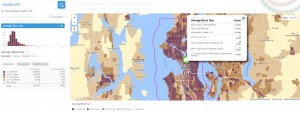A Placemaking Journal
Hurricane Harvey Provides a Sober Reminder that Resilience is about Mitigation and Adaptation
Most of us faraway bystanders are observing Houston’s response to Hurricane Harvey with concern at the devastation as well as encouragement at the stories of compassion. With sympathy to the current human suffering from Harvey, we are wishing Houstonians continued strength, fortitude, and safe passage this week. No amount of comprehensive planning or zoning reform can prepare a city for the sort of flood Houston is currently experiencing. An expected 50” of rain in a few days makes this an event that no place in the world is likely to sustain without massive personal and economic impacts. Perhaps not even the Netherlands, who has led the world in stormwater management for hundreds of years, with protection, prevention, and preparedness.
This volume is more rainfall in 3 days than annual amounts in very wet regions. The rainiest cities in the U.S. – Mobile, Pensacola, and New Orleans – average 67”, 65” and 64” of rain per year. Portland and Seattle average 36” and 37”. 50” in a few days is highly unusual in hurricane history, and is perhaps a 1,000-year flood. That means that there is a 1 in 1,000 chance of it happening in any given year, and not that we should only expect an event of this magnitude every 1,000 years, an important but counterintuitive distinction. Regardless of what kind of planning Houston would’ve done, preparation for this intensity is a challenge.
A good deal of brilliance has been shone on how climate change is – and is not – involved in progressively more extreme storm events, like this piece by David Roberts. Clearly, we must both adapt and mitigate climate effects as quickly as we can. It is becoming increasingly clear that adaptation and mitigation isn’t an either/or choice.
Those of us in the city planning trenches are getting a jolting reminder this week that it’s time to have a very serious conversation everywhere about how to handle flooding issues. My fellow PlaceMaker, Ben Brown, who was a lead facilitator after Hurricane Katrina and the BP Oil Spill, cautions that it is way too early to do a significant analysis of stormwater systems in Houston, but there’s no doubt that every coastal city will be faced with upgrading its planning after this event, leading to more stormwater infrastructure investments to adapt.
“The danger is that everyone gets committed and galvanized when it comes to rescuing people, but there are parts of Mississippi and Alabama that are still in recovery mode many years after Hurricane Katrina and the BP Oil Spill,” Ben Brown points out. “We need to get ready for a critical discussion about public investment in infrastructure that we’ve delayed in hopes that the challenges of these events might not be as extreme as they are turning out to be.”

Places that have had a serious go at mitigating climate change – which means both reducing greenhouse gas emissions (renewable energy, compact development patterns, decreased car dependence) and modifying the landscape (urban heat islanding mitigation, tree canopy restoration, pervious landscapes) – have shown they can keep up with the rate of reduction on the emissions side, according to CNT‘s Scott Bernstein. He says, “It is not too late to replace global warming with local cooling. Making cities act more metabolically with biomimicry is essential.”
Seattle is a great example, at 40 years into a massive retrofit program to get rid of their fossil fuel power generation. But it hasn’t done as well to mitigate transportation emissions. Two-thirds of the emissions for Seattle is from transportation, with the other third from buildings and energy. In Chicago, it’s just the opposite. Chicago is inherently more transportation efficient because it’s more compact and held onto legacy transit systems, but did not go green on power generation. Seattle has a milder climate, but transportation emissions grew. The Northwest has had a federally funded green power portfolio, while Chicago’s nuclear power plants have been shutting down.
CNT’s H+T Index was just updated two weeks ago with data through 2015, calculating household greenhouse emissions and covering more rural areas than in its last rendition.
The H+T Index shows Seattle has fewer small connected blocks and walkable urban areas and less coverage by frequent transit service than Chicago. On average, this yields 1 additional metric ton per household per year of GHG from personal transportation, or about 300,000 total additional metric tons for the city as a whole per year. Seattle is trying to achieve a reduction of 80% by 2050. Between now and 2050, without improvement in the personal transportation sector, Seattle’s households will be directly responsible for an additional 10 million metric tons of CO2 equivalent emissions compared to the same number of average Chicago households.
Another CNT tool, RainReady, is in the process of collecting insurance info to map where it floods and how often. For Cook County, Illinois, 70% of flooding happens outside of the FEMA floodplain boundaries. Everywhere else in Illinois, 92% of flooding happens outside the FEMA floodplain boundaries. These boundaries indicate where the national flood insurance is willing to underwrite, another indicator that our support systems aren’t fully aligned with today’s climate reality. Dallas News backs this up pointing to the likelihood that many Texans caught in the flooding don’t have flood insurance.
Bernstein notes, “The idea of urban diplomacy in international circles represents the commitments by cities to climate protection and more recently those made in the face of the US pulling out of the Paris climate agreement. The Compact of Mayors, the Deep Carbon Reduction framework, and The Mayors Innovation Project are essential resources for cities aspiring net zero emissions. Paul Hawken’s new project and book, Drawdown, does a modest job of addressing the importance of walking and cycling in an attempt to reverse global warming, and the solutions are available open source. But so far, not much useful has been written that prioritizes place-based, right-sized climate-protecting urbanism.”
The CNU Climate Summit next month in Washington, DC, hopes to help fill that gap. While this event is sold out, many of the thought leaders are available from the Seattle CNU 25 videos, notably Doug Farr and Andrés Duany. And our PlaceShakers resilience series provides some insights. Additional links to key resources appreciated in the comment section below. Our global commons problem will take all of us.
–Hazel Borys
If PlaceShakers is our soapbox, our Facebook page is where we step down, grab a drink and enjoy a little conversation. Looking for a heads-up on the latest community-building news and perspective from around the web? Click through and “Like” us and we’ll keep you in the loop.











